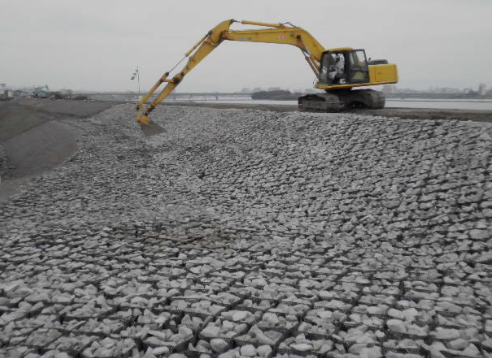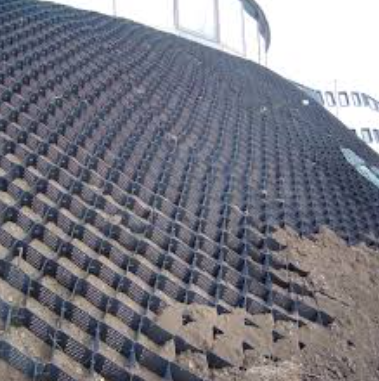- Understanding the Role of Geomembrane Liners in Waste Management
- Innovations in Geomembrane Liners for Water Management
- Geomembrane Liners: A Comprehensive Guide
- The Future of Geomembrane Liners in Civil Engineering
- Geomembrane Liners: Enhancing Landfill Stability
Manager:
WhatsApp:+86 177 0135 2670
Tel:+86 177 0135 2670
Email:marketing@okorder.com
Address:3rd Floor, No.2 Building, No.1 Sanlihe Road
What is a geocell for slope protection?
Introduction
In the realm of civil engineering and environmental protection, the concept of slope protection holds immense significance. Slopes are susceptible to erosion, instability, and degradation due to various natural and human-induced factors. To counter these challenges, engineers and environmentalists have devised numerous techniques, one of which involves the utilization of geocells. But what exactly is a geocell for slope protection, and how does it contribute to safeguarding vulnerable terrains? This article aims to delve into the intricacies of geocell slope protection, exploring its definition, applications, benefits, and the mechanisms behind its effectiveness.

Understanding Geocell Slope Protection
Geocell slope protection refers to the application of geocells, also known as cellular confinement systems, to reinforce and stabilize slopes, embankments, and other terrain surfaces prone to erosion and instability. Geocells are three-dimensional honeycomb-like structures fabricated from high-density polyethylene (HDPE) or other durable materials. These cells are interconnected and filled with soil, aggregate, or other suitable infill materials, forming a coherent and reinforced structure.
The Role of Geocells in Slope Protection
Geocells serve multiple functions in slope protection endeavors:
1. Enhanced Soil Stability: By confining the soil within the cells, geocells significantly improve soil stability and shear strength, thereby reducing the risk of slope failure and erosion.
2. Erosion Control: The interconnected structure of geocells effectively mitigates surface erosion by preventing soil displacement and promoting vegetation growth.
3. Load Distribution: Geocells distribute external loads, such as vehicular traffic or hydrostatic pressure, evenly across the slope surface, minimizing localized stress concentrations and preserving the integrity of the terrain.
4. Steep Slope Reinforcement: Geocells enable the construction of steeper slopes than would be feasible with conventional methods, allowing for efficient land utilization while maintaining stability.
Applications of Geocell Slope Protection
Geocell slope protection finds wide-ranging applications in various sectors:
1. Transportation Infrastructure: Geocells are utilized along highways, railways, and embankments to reinforce slopes, prevent soil erosion, and ensure the longevity of infrastructure projects.
2. Environmental Conservation: In environmentally sensitive areas such as riverbanks, coastal regions, and hillsides, geocells are employed to protect against erosion, preserve natural habitats, and promote ecological restoration.
3. Mining and Quarrying: Geocells play a crucial role in mining and quarrying operations by stabilizing overburden slopes, controlling erosion, and facilitating reclamation efforts.
4. Civil Engineering Projects: From residential developments to industrial complexes, geocell slope protection is integrated into various civil engineering projects to safeguard structures and landscapes against the adverse effects of slope instability and erosion.
Benefits of Geocell Slope Protection
The adoption of geocell slope protection offers numerous advantages:
1. Cost-Efficiency: Geocells are cost-effective compared to traditional slope stabilization methods, as they require less material, labor, and maintenance over the project's lifecycle.
2. Versatility: Geocells can be customized to suit the specific requirements of different slope gradients, soil types, and environmental conditions, making them highly versatile in diverse applications.
3. Rapid Installation: Geocells are easy to install and can be deployed quickly, minimizing construction downtime and facilitating expedited project completion.
4. Longevity: Geocell systems exhibit exceptional durability and resistance to environmental degradation, ensuring long-term stability and performance even in harsh climatic conditions.
5. Environmental Sustainability: By promoting vegetation growth and minimizing soil disturbance, geocell slope protection contributes to environmental sustainability and ecosystem preservation.
Mechanisms of Geocell Slope Protection
The effectiveness of geocell slope protection is attributed to several key mechanisms:
1. Confinement Effect: The confinement provided by geocells restricts soil movement and enhances interlocking between soil particles, resulting in improved shear strength and stability.
2. Flexibility: Geocell structures are inherently flexible, allowing them to accommodate ground movement and settlement without compromising their integrity.
3. Hydraulic Performance: Geocells facilitate efficient drainage and water infiltration, reducing hydrostatic pressure and preventing saturation-induced slope failures.
4. Vegetation Encouragement: The open cells of geocells create microenvironments conducive to vegetation growth, further reinforcing the slope and enhancing erosion resistance.

Conclusion
In conclusion, a geocell for slope protection represents a versatile and effective solution for mitigating erosion, stabilizing terrain, and safeguarding critical infrastructure and ecosystems. By harnessing the principles of confinement, flexibility, and environmental sustainability, geocell slope protection offers a cost-efficient and durable alternative to conventional slope stabilization methods. As the demand for resilient and sustainable slope protection solutions continues to grow, the role of geocells in civil engineering and environmental conservation endeavors is poised to expand, ensuring the resilience and longevity of landscapes and infrastructure worldwide."
- Previous:What is the lifespan of a Geocell?
- Next:What is the difference between a geocell and a geogrid?






